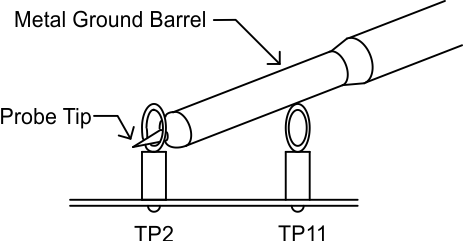SLVU728A May 2012 – December 2021 TPS53318 , TPS53319
- 1 Introduction
- 2 Electrical Performance Specifications
- 3 Schematic
- 4 Test Setup
- 5 Configurations
- 6 Test Procedure
-
7 Performance Data and Typical Characteristic Curves
- 7.1 Efficiency
- 7.2 Load Regulation
- 7.3 Line Regulation
- 7.4 Enable Turn-On/ Turn-Off
- 7.5 Output Ripple
- 7.6 Switching Node
- 7.7 Output Transient with Auto-skip Mode
- 7.8 Output Transient with FCCM mode
- 7.9 Output 0.75-V Pre-bias Turn-On
- 7.10 Output Overcurrent and Short Circuit Protection
- 7.11 Bode plot
- 7.12 Thermal Image
- 8 EVM Assembly Drawing and PCB Layout
- 9 Bill of Materials
- 10Revision History
4.1 Test Equipment
Voltage Source:
The input voltage source, VIN, should be a
0-V to 20-V variable DC source capable of supplying 10 ADC. Connect
VIN to J1 as shown in Figure 4-2.
Multimeters:
V1: VIN at TP1 (VIN) and TP10 (GND). V2: VOUT at TP2 (VOUT)
and TP11 (GND). A1: VIN input current
Output Load:
The output load should be an electronic constant
resistance mode load capable of 0 ADC to 16 ADC at 1.5 V.
Oscilloscope:
A digital or analog oscilloscope can be used to
measure the output ripple. The oscilloscope should be set for the following:
- 1-MΩ impedance
- 20-MHz bandwidth
- AC coupling
- 2-μs/division horizontal resolution
- 20-mV/division vertical resolution
Test points TP2 and TP11 can be used to measure the output ripple voltage by placing the oscilloscope probe tip through TP2 and holding the ground barrel on TP11 as shown in Figure 4-1. Using a leaded ground connection can induce additional noise due to the large ground loop.
 Figure 4-1 Tip and Barrel
Measurement for VOUT Ripple
Figure 4-1 Tip and Barrel
Measurement for VOUT RippleRecommended Wire Gauge:
- VIN to J1 (12-V input):
The recommended wire size is AWG #16 per input connection, with the total length of wire less than four feet (two feet input, two feet return). - J2 to LOAD:
The minimum recommended wire size is AWG #14, with the total length of wire less than four feet (two feet output, two feet return).